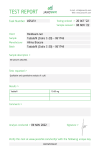Why is it important for athletes to monitor their blood pressure?
Blood pressure (BP) is the pressure of blood on the arterial walls, which depends on the amount of blood flowing from the heart, blood flow, the resistance of the peripheral arteries, and the elasticity of the arterial walls.
Blood pressure (BP) is divided into: systolic (maximum) blood pressure, diastolic (minimum) blood pressure, pulse blood pressure.
Systolic (maximum) blood pressure is the pressure in the arterial system during the maximum rise of the pulse wave that occurs after left ventricular systole
Diastolic (minimum) blood pressure occurs at the end of diastole of the heart, when the pulse wave subsides.
Pulse pressure is the difference between the systolic (maximum) and diastolic (minimum) pressure.
Dynamics is the course of development, change of any phenomenon, that is, the change in a phenomenon under the influence of external or internal factors.
Nowadays - hypertension is related to hypodynamics of people. Computer technology is actively developing, and as a consequence, active physical work has decreased. Now let's imagine a person has a problem and additionally starts using steroids.
Measuring blood pressure has become an indispensable everyday task for everyone. But it should be taken into account that blood pressure is influenced not only by our lifestyle and work, but also by our diet and various diseases, and of course diseases affect it indirectly. During a day BP values change. They change depending on age, diet and psychological state. Some of these factors have a direct effect on BP changes, others have an indirect effect.
But it is also necessary to take into account the working pressure, which is optimal and individual for the body. Its variation indicates ailments in health and requires the correct organization of the daily regime and diet.
And as a result - a significant increase in the risk of stroke, coronary heart disease, congestive heart failure, other cardiovascular diseases and events, significantly increasing disability and mortality among patients. Overall, 80% of these patients die due to cardiovascular disease: 65% from acquired cardiac abnormalities, 15% from cerebral circulatory disorders
Among patients with arterial hypertension, the prevalence of diabetes mellitus is 2-2.5 times higher than among those without high blood pressure. In addition, the risk of diabetes over the next 5 years in patients with hypertension is 2.5 times higher than in the general population. The likelihood of developing hypertension in the background of diabetes increases depending on the type of diabetes, the age and ethnicity of the patient, the presence of obesity and other components of the metabolic syndrome. As a result, more than 80% of patients with type II diabetes suffer from elevated BP. As we can see, this problem can provoke other problems.
Most people believe that high blood pressure is one of the most common side effects of using certain substances in training. This assumption was largely based on the results of animal experiments. The action of some substances causing hypertension is still a matter of speculation, but it has been suggested that elevated levels of 11-deoxycorticosterone may be the cause. Who isn't in the tank: It's a minor
mineralocorticosteroid hormone of the adrenal cortex in
humans. In some
animal species, deoxycorticosterone is the primary natural mineralocorticoid. But in humans, deoxycorticosterone is relatively inactive, and
aldosterone is the main human mineralocorticoid. Deoxycorticosterone, unlike both
aldosterone and
glucocorticoids, increases skeletal muscle strength and endurance. The mechanism of this action of deoxycorticosterone is poorly understood.
However, some preparations inhibit 11P-hydroxylation of 11-deoxycorticosterone to corticosterone. When this chemical pathway is blocked, the amount of 11-deoxycorticosterone increases, having an effect similar to the excessive cortisol secretion in Cushing's syndrome.
Other suspected mechanisms include increased peripheral vascular resistance due to increased reactivity to norepinephrine. This may increase renal secretion of renin, the hormone responsible for regulating circulatory function through the kidneys and thus affecting blood pressure. These hypotheses are by no means conclusive, and experimental evidence from human studies is not yet available.
However, the presence of hypertension has not been confirmed by observational studies of users of certain types of drugs, much less bioengineered drugs. Most of them find no difference when monitoring blood pressure after taking the athlete's support from outside. However, other studies have reported statistically significant increases in blood pressure when certain drugs are used. It is necessary to pay attention to the body's margin of safety and to exclude other pathologies that may affect the body negatively. Therefore, you should be careful to monitor your body when preparing.



